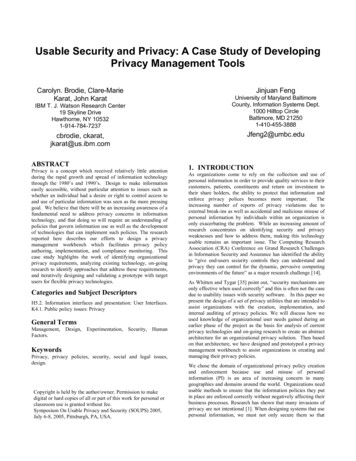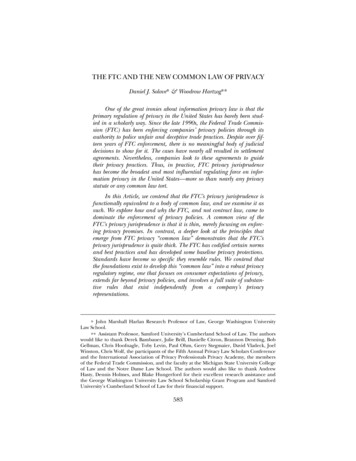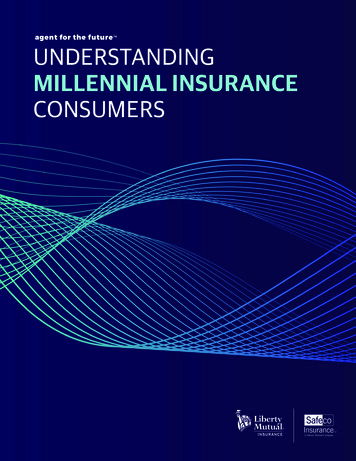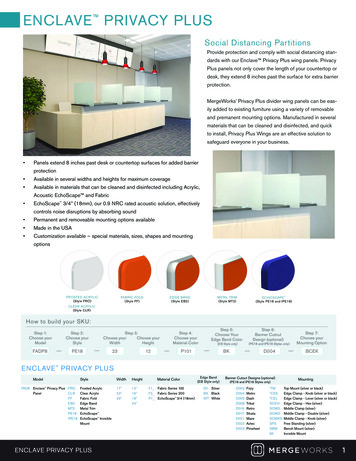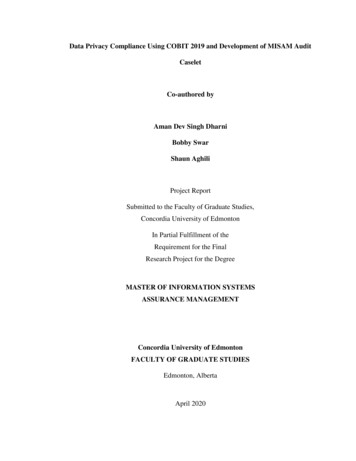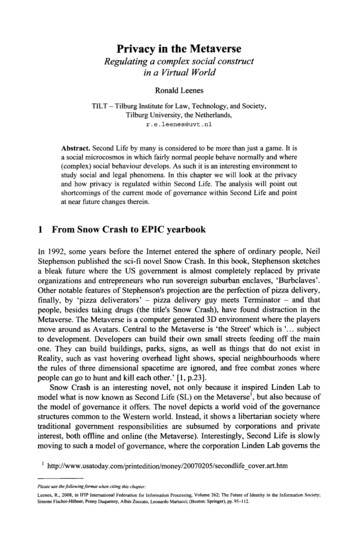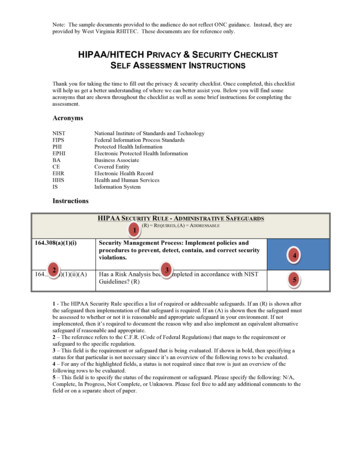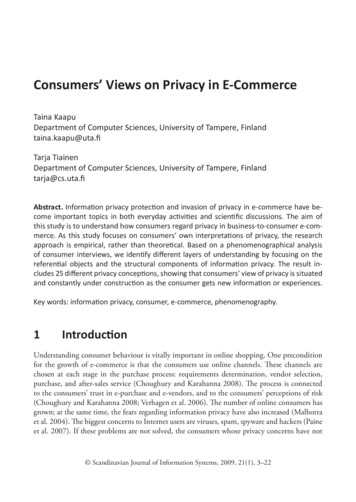
Transcription
Consumers’ Views on Privacy in E-CommerceTaina KaapuDepartment of Computer Sciences, University of Tampere, Finlandtaina.kaapu@uta.fiTarja TiainenDepartment of Computer Sciences, University of Tampere, Finlandtarja@cs.uta.fiAbstract. Information privacy protection and invasion of privacy in e-commerce have become important topics in both everyday activities and scientific discussions. The aim ofthis study is to understand how consumers regard privacy in business-to-consumer e-commerce. As this study focuses on consumers’ own interpretations of privacy, the researchapproach is empirical, rather than theoretical. Based on a phenomenographical analysisof consumer interviews, we identify different layers of understanding by focusing on thereferential objects and the structural components of information privacy. The result includes 25 different privacy conceptions, showing that consumers’ view of privacy is situatedand constantly under construction as the consumer gets new information or experiences.Key words: information privacy, consumer, e-commerce, phenomenography.1IntroductionUnderstanding consumer behaviour is vitally important in online shopping. One preconditionfor the growth of e-commerce is that the consumers use online channels. These channels arechosen at each stage in the purchase process: requirements determination, vendor selection,purchase, and after-sales service (Choughury and Karahanna 2008). The process is connectedto the consumers’ trust in e-purchase and e-vendors, and to the consumers’ perceptions of risk(Choughury and Karahanna 2008; Verhagen et al. 2006). The number of online consumers hasgrown; at the same time, the fears regarding information privacy have also increased (Malhotraet al. 2004). The biggest concerns to Internet users are viruses, spam, spyware and hackers (Paineet al. 2007). If these problems are not solved, the consumers whose privacy concerns have not Scandinavian Journal of Information Systems, 2009, 21(1), 3–22
been addressed may delay their purchases or even forgo them, and some concerned consumersmight prefer traditional ways of purchasing (Prabhaker 2000).To deal with these concerns, privacy enhancing technologies (PETs) have been developed:software programs, hardware devices and even publications, which help users to regain their privacy lost on the Internet (Camp and Osorio 2003). Legal instruments for increased security havebeen formulated as well: for example, the European Union (EU) requires all its member states tolegislate to ensure that their citizens have a right to privacy (Directive 95/46/EC).On a practical level, e-vendors work to increase online purchasing. Research in information systems (IS) and consumer studies aims to increase understanding about e-commerce andconsumers’ online behaviour (see e.g., Cassidy and Chae 2006; Hui et al. 2007; Malhotra et al.2004). Our paper belongs to the same research area, although we focus solely on informationprivacy. According to the traditional definition, information privacy is the ability of the individuals to control information about themselves (Westin 1967). Instead of concentrating on traditional and direct marketing, as done in several former studies (e.g., Smith et al. 1996, Stewartand Segars 2002), we seek to understand how consumers view information privacy in businessto-consumer (B2C) e-commerce. In doing so we aim to present and discuss the subject matter sothat business and legislative authorities can adequately respond to and address these consumers’needs and fears. This is necessary to allow maximizing the potential of e-commerce.Theory testing with surveys is a commonly used research method in studying Internet privacy. A typical study asks about informants’ attitudes towards specific privacy statements withfixed scale (e.g., Cassidy and Chae 2006; Malhotra et al. 2004). In theory testing studies, theresearcher—based on the theory under testing—defines how information privacy is conceptualized. However, it is important to take a step back and investigate how consumers understandprivacy in everyday practice.To fill this gap in the literature, we decided to use a qualitative research approach for gettinga richer picture of consumers’ views. Instead of seeking the dominant view or an average one,we focus on the differences in views. We decided to concentrate on the variation of consumers’interpretations as consumers are not a homogenous group. In most consumer studies, consumers are divided to groups based on their demographical variables, income or attitudes. Westincategorized consumers based on their attitudes towards privacy; to categories of privacy fundamentalists (who feel that they have lost their privacy), privacy pragmatists (who protect theirpersonal information), and privacy unconcerned (who have no real concerns about privacy)(Taylor 2003).Our aim is to focus on all types of consumers’ views on information privacy without categorizing consumers beforehand. First, we seek what earlier studies say on consumers’ interpretations of information privacy. In doing this, we briefly describe the concept of privacy asdiscussed in the previous literature. Then, we describe the research methods used in our study:as we look for alternative views, we use phenomenography and consumer interviews. After themethodological part, we offer the results in a form of categorization of consumers’ views basedon the analysis of the interview material. The results show that consumers’ interpretation ofinformation privacy is situated; it varies between familiar, trusted cases and unknown cases perceived as suspicious. Finally, we present the discussion and conclusion.4 Kaapu & Tiainen
2Research backgroundIn this section, we describe the scope of Internet privacy studies for locating our study to theappropriate scientific field. Privacy is characterized according to the traditional definition as “theclaim of individuals, groups, or institutions to determine for themselves when, how, and to whatextent information about them is communicated to others” (Westin 1967, (pp. 6-7). Invasionsof privacy occur when individuals cannot maintain an adequate degree of control over theirpersonal information and its use (Chung 2003). We follow the generally accepted view of information privacy by seeing it as the ability of individuals to control information about themselves(e.g., Cheung and Lee 2006; Graeff and Harmon 2002; Udo 2001).Online information privacy has been studied in the disciplines of law and public policy,marketing, organisational behaviour, and IS (Malhotra et al. 2004). One way to see privacy isto understand it as a legal concept (e.g., Curran and Richards 2004). Although the concept ofprivacy itself may sound straightforward, the regulatory laws vary between cultures (Milberg etal. 1995). Developed societies have made different assumptions about privacy in their societalregulatory approaches. The societies can be roughly sorted into two categories: First, to thosewho view privacy as a human right, as is the case in the EU (Bygrave 1998), for example, wheremeasures that address all the data collection and use within society are being introduced. Second, to societies which view privacy as a matter for contractual negotiation, such as the UnitedStates and Japan, for example, where the laws are specific to various sectors (e.g., medical data)(Smith 2004).There exist contradictory views on privacy and benefits for consumers, for example about thecollection of personal information. It can be seen as a positive matter, since personalized services cannot be created without personal information. However, consumers’ hopes in this areaare paradoxical: easy, personalized services are in demand but collecting personal informationis resisted (Awad and Krishnan 2006). While the freedom of movement of information and itsbenefits to the general public have been emphasized (e.g., Bergkamp 2002; Rubin and Lenard2002), the somewhat opposite view sees personal information registers as unreliable, and theaim of the laws has been to limit their use. Thus, the latter view focuses on threats such as morewidespread profiling when handling personal information (e.g., Graeff and Harmon 2002; Liuet al. 2005) and consumers’ continuous on-line monitoring (e.g., Kruck et al. 2002; McRobband Rogerson 2004; Smith 2004).Consumers’ lack of trust constitutes a major psychological barrier to the adoption of ecommerce (Cheung and Lee 2006). Consumers’ privacy concerns have been studied with theoretically based surveys, with varying results (e.g., Udo 2001; Malhotra et al. 2004). For example,consumers’ privacy concerns are stated to be related to the following aspects of data collectionand use (Smith et al. 1996; Stewart and Segars 2002): 1) unauthorized collection, 2) errorsrelated to the integrity of databases, 3) unauthorized secondary use, and 4) improper access topersonal data. Some studies present concerns in a more concrete way, as listed in the following(e.g., Cassidy and Chae 2006; Chung 2003):Consumers’ Views on Privacy in E-Commerce 5
1. Visits to websites might be secretly tracked.2. E-mail addresses and other personal information could be taken and used without permission for marketing or other purposes.3. Personal information could be sold without permission to third parties.4. Credit card information could be stolen.One of the other types of categorizations is presented by Paine et al. (2007), which states thatthe consumers’ main concerns about online privacy are viruses, spam, spyware and hackers.Malhotra et al. (2004) conceptualize Internet users’ information privacy concerns asThe degree to which an Internet user is concerned about online marketers’ collection ofpersonal information, the user’s control over the collected information, and the user’sawareness of how the collected information is used (Malhotra et al, p. 338).They also developed a causal model to describe how concerns influence a consumer’s decision torelease or not release personally identifiable data.E-vendors can do a lot for mitigating the consumers’ fears related to privacy. Informationon how companies maintain and use personal information increases consumers’ trust (Liu et al.2005). The presence of a vendor’s online privacy policy decreases consumers’ privacy concerns(Hui et al. 2007; Jensen et al. 2005; Pan and Zinkhan 2006). At least in some cases, consumerstrust e-vendors (e.g., Gefen et al. 2003) and are not afraid of privacy problems with them, suchas e-vendors selling personal information to third parties (Cheung and Lee 2006).The above studies present at least partly contradictory findings, which makes consumers’views on information privacy an important issue to study further. Consumers’ behaviour is usually studied in a conventional direct marketing environment (Phelps et al. 2000). These studies are most often based on demographical factors, and the differences that are found include(Graeff and Harmon 2002): Gender differences: men are less concerned about privacy issues than women, and menhave more faith in purchasing on the Internet; Class differences: the consumers with high incomes want to know more about theirinformation after collection than other consumers; Age differences: older people are less likely to believe that their information might besold to others for marketing purposes.Furthermore, the global nature of e-commerce makes privacy issues even more complex, becausethe perceptions of privacy and fair information practices depend on government regulations andvary across cultures (Bellman et al. 2004; Milberg et al. 1995).Information privacy is focused in different areas, such as consumers’ behaviour (see Table1 for a summary). Although some studies (e.g., Jensen et al. 2005; Paine et al. 2007) ask fora deeper understanding of consumers’ thought-models, almost all studies have used a theorytesting research approach with surveys or laboratory tests. The only exception we could find isthe study by Hui et al. (2007), in which field observations were made in a local firm focusing onprivacy statements. Our study belongs to the same empirically based approach among qualitative studies, focusing on the consumers’ own interpretations of information privacy. In this ap6 Kaapu & Tiainen
proach, rather than building our research on some earlier studies with their underlying assumptions, we must be as open minded as possible to reach the consumers’ own thought-models. Ouraim is to find out what these consumers exactly mean when they discuss information privacy.However, the concept of information privacy may signify different issues or concerns todifferent people. This paper aims to clarify this with the help of a categorization of consumers’views of information privacy in e-commerce. The study has both theoretical and practical contributions. On the theoretical side, we discuss the consequences of our empirical results vis-à-visthe existing literature. On the practical side, we give important guidelines in order to understandconsumers’ concerns about privacy in the online environment.Areas of information privacy studiesExample references1. Defining privacyWestin 19672. Legal issues about privacyBygrave 1998Cassidy and Chae 2006Camp and Osorio 2003McRobb and Rogerson 2004Prabhaker 2000Awad and Krishnan 2006Graeff and Harmon 2002Taylor 20033. Technology for privacy (Privacy Enhancing Technologies)4. Vendors’ actions to increase privacy5. Consumers’ actions in relations to privacy, which isstudied based on:- Consumers’ demographic factors- Consumers’ attitudes, valuesand behavior6. Consumers’ privacy concerns:- Personal information: collection, unauthorizedsecondary use, improper access, errors, stealing- On-line monitoring- Viruses, spam, spyware and hackersChung 2003Malhotra et al. 2004Paine et al. 2007Stewart and Segars 2002Table 1: Focal areas of information privacy studies3MethodologyOur aim is to understand how consumers see privacy and to describe the differences in theirviews in e-commerce. For studying people’s own interpretations of a concept (information privacy in this case) a qualitative method which focuses on people’s narration is needed. Individuals’ views are socially constructed; however, the individuals’ own background, includingtheir education and experience, can also have effect on their views. Methods such as discourseanalysis, grounded theory (GT), and phenomenography can thus be considered. In choosing theresearch method, we discarded discourse analysis, since it has its focus on social interaction, suchas shared (communal) views and argumentations (Alvesson and Karreman 2000).A decision between GT and phenomenography was made based on their different studyaims. Although they both itemize individuals’ talk to its elements, the target of that processConsumers’ Views on Privacy in E-Commerce 7
is different. GT re-ties the elements together for a whole picture of the phenomenon understudy (Glaser and Strauss 1973), whereas phenomenography aims for reaching all the alternative views or the structures of individual thought-models (Marton and Booth 1997). As somethought-models are richer and more versatile than others, the result forms a hierarchical structure. Phenomenography is about individual meaning construction, which results in a conception referring to conceiving and understanding something. Humans’ experience of the worldis constituted as an internal relation between the experiencing people and the world (Marton1981). Conceptions are regarded as ground for action (Säljö 1994).Phenomenography was introduced by educational researchers (Marton 1982). It has beenused for educational studies also in the IS field in clarifying computer science students’ conceptions of recursion (Booth 1992) and in finding out about moral conflicts in the project workcourse (Vartiainen 2007). The method is also used for analysing IS professionals’ assumptionsabout the human being (e.g., Isomäki 2002). Here we use the method for analysing IS users’views. Our study focuses on non-professional people whose knowledge of technology is limited; they might have erronous views about what is possible and what is not over the Internet.Regardless, in this study we do not evaluate the workability of their presented assumptions. Itis enough that the informant believes in them, and that they thus may affect his/her behaviour.These concepts will be made explicit to allow IS professionals to understand them.In phenomenography, empirical material is typically collected by interviewing a relativelysmall number of relevant informants. The main point when choosing these is to reach the largestpossible differentiation in their views (Marton and Booth 1997), similar to theoretical samplesin other qualitative methods (see e.g., Glauser and Strauss 1973). We maximize the differentiation in privacy conceptions with the help of two interview settings. The first one focused onprivacy, and the views there were directly elicited from the interviewees: they were asked to describe privacy in the Internet setting in their own words. When a question about a phenomenonis asked directly, there is a chance that the informants repeat the dominant discourse of the issue;this can be regarded as the shared view by the society (Hynes et al. 2006). In this study the aimwas to reach all the alternative views: therefore, besides of direct asking, we also discussed privacyindirectly. The second interview focused on the use of electronic services; privacy was expectedto be an underlying assumption to emerge in the interviews.The interviewees were sought in several ways. One criterion in the selection was age. Unlikein many studies that use young informants (e.g., Cheung and Lee 2006; Gefen et al. 2003), wealso sought older people’s views. Having them in our interview group increased the chance ofeliciting a larger variety of concepts: the older people seem to be the most passive in data protection issues while well-educated, young, heavy Internet users are the most active group (Grableand Joo 1999; Muttilainen 2006).In the first interview set, individuals known by the researchers were directly asked for interviews. Also, the snowball method was used; the interviewees were asked to name other possibleinterviewees, especially those who might have (different) opinions on privacy. The first interviewset based on direct questions about information privacy included twelve interviews.For the second interview set, volunteers were found by advertising on a local newspaper’swebsite and in an e-commerce seminar. Volunteers needed to fill in an Internet form indicatingtheir age, sex, and values. For identifying the values, the volunteers rated each of the listed valuesand specified the most and the least important values. The list of values included: 1. sense of8 Kaapu & Tiainen
belonging, 2. excitement, 3. warm relationship with others, 4. self-fulfillment, 5. being well-respected, 6. fun and enjoyment in life, 7. security, 8. self-respect, and 9. sense of accomplishment(based on List of Values (LOV) by Kahle et al. 1986). In the selection of interviewees our aimwas to maximize the differentiation in participants’ views. As the former studies highlight information privacy concerns, we decided to use two values that are related to safety (security andexcitement). Of the twenty volunteers who filled in the form we selected five security-mindedand five excitement-minded consumers. Their interview focused on the use of e-services.We did not study the relationship between the interviewees’ background and the privacyview, so the interviewees’ backgrounds are not significant for the analysis. However, we are awarethat the variation among interviewees’ background might help in reaching the largest possiblevariation in views. A brief description of their backgrounds is shown in Table 2. This may helpthe reader to better understand the empirical base of this study.The aim of phenomenographical study is to describe the differentiation between individualsas regards the phenomenon under study. In collecting data, the interview situation affects whatpeople say and how they say it; furthermore, due to bias caused by personal education and otherbackground, researchers may ignore some ideas mentioned by the informants (Eriksen 2001).To minimize this problem, we varied the interview situation: in the first interview set there wasone interviewer, and in the second set there were two interviewers.IntervieweesAgeBetween 25 and 35 yearsBetween 36 and 54 yearsBetween 55 and 66 yearsTotalOccupational backgroundBusiness and administrationHealth and social affairsTeaching and educationTechnological 24432134211198643122Table 2: Consumers interviewedOtherwise, the interviewing progress was alike in both of the interview sets. The individual interviews were open-ended, and only the topics were decided beforehand. The interviews startedfrom a general discussion about the interviewees’ backgrounds (as consumers in e-commerce)and were followed by a discussion about the main issue (which concerned, in the first set,privacy issues in e-commerce and, in the second set, e-services in the form of e-journals and ecommerce). The duration of the interview situations varied from thirty minutes up to two hoursand thirty minutes. The interviewer’s role was to follow the interviewees’ ideas and explore theirnarration.Consumers’ Views on Privacy in E-Commerce 9
The interviews were collected during spring and summer 2004 in Finland. They were transcribed and their text then analysed. In phenomenographical studies, the analysis focuses ontwo components in the informants’ experiences of the phenomenon; the referential component—which describes what the phenomenon means in everyday language—and the structuralcomponent—which refers to a deeper level of phenomenal meaning (Marton and Booth 1997).The what aspect directs individuals’ thought to the object, which can be physical or mental bynature. The how aspect refers to the thought processes by which an object of thought is limitedin relation to its environment (Marton 1981). In phenomenography, the conceptions are intentional with respect to the two intertwined aspects, which signify the qualitative differencesamong conceptions. The aspects render the relation that a conception constitutes between anindividual and the surrounding world as contextual (Marton and Booth 1997).In our study, at first the focus in analysis was on the referential component, i.e., on what theinterviewees meant with privacy on the level of everyday language. They described the details ofprivacy and the problems related to keeping their privacy. The interview texts were split in smallitems—each of them included one aspect or a problem of privacy. The items were categorizedin order to obtain a single dimension of the categorization at time—first, the what aspect of thefinal categorization. The analysis continued by focusing on the structural component of privacyviews. Structure is reached by analysing the target of the referential component. In the finalcategorization, this is the how aspect.4 Result: Categorization of consumers’ viewsOur study deals with how consumers see information privacy. The results present different layersof understanding in two dimensions. The first dimension is the referential component whichfocuses on the meaning of privacy in the interviewees’ everyday language (Table 3 columnsA-E; What). The second dimension is the structural component which focuses on the form ofWhatHow1. Product ande-vendor2. Technology3. Societalnorms4. Consumerhim/herself5. Fellow menA. Use andmisuse ofcustomerinformationB. MonitoringconsumersC. Threat ofspamD. Danger ofhackers andvirusesE. Risk B5C5D5E4A5ATable 3: Summary of the categorization of consumers’ information privacy conceptions ine-commerce10 Kaapu & Tiainen
thought when the interviewees talk about privacy (Table 3 rows 1-5; How). By the two dimensions we identify a total of 25 different privacy conceptions. Table 4 includes one example ofeach conception to illustrate the content.The referential component (the what aspect) of information privacy consists of five objects.Use and misuse of customer information includes consumers’ personal information and how itis used, especially concerning its misuse. The second object, monitoring consumers, refers tomonitoring consumers’ actions when they are using e-commerce systems. Threat of spam refersto e-mails that a consumer interprets as spam as a part of privacy demands. Danger of hackers andviruses relates to hackers (who spread viruses) as a factor to intrude privacy. Risk with paymentrefers to issues related to making payments on the Internet that can create problems of privacy.The other dimension, structural components (rows in Table 3, or the how aspect) shows different forms of thought and stress the structural aspect of the conceptions. It includes five objects.When a consumer gives personal information in order to purchase a product in a certain e-shop,the focus is on products and maybe also on the e-vendor. Furthermore, there are systems (ortechnology) to deliver the product to the right person. It may be regarded as safer to order fromthe home country than from abroad (societal norms), the consumer may make an error whenwriting the order (consumer him/herself ), and there may be a family member watching over his/her shoulder (fellow men).4.1 Referential objects of information privacyThe referential objects (Table 3: columns) are presented in the order of which they were emphasized by the interviewees as a group, taking into account how much they discussed each object: All (22) interviewees talked about use and misuse of customer information. 20 interviewees talked about monitoring consumers. 15 interviewees talked about threat of spam. 14 interviewees talked about danger of hackers and viruses. 9 interviewees talked about risk with payment.When the interviewees described information privacy, in most of the cases they connected itto possible problems. Four categories of the referential components focus on problems onlyand just one on both use and misuse. The result of our study does not state anything about thefrequency of specific views among the whole population; however, all the five referential objectsexist in people’s thinking about privacy.Object A: Use and misuse of customer information. In the interviews, the consumers mostlydiscuss their personal information as customer information. This is information which e-vendors collect by asking it from consumers. Some of the interviewees use the concept “customerinformation”, others underline their own viewpoint by talking about “my information that mye-vendor has or knows”. In general, the interviewees are reluctant to give their informationand they are afraid of misuse of their personal information – but only if they do not know thee-vendor beforehand. Nevertheless, the consumers interviewed also understand the benefits ofConsumers’ Views on Privacy in E-Commerce 11
ConceptionUse and1A (product)misuseof customer2A (technology)informa3A (soc norms)tion4A (consumer)5A (fellow men)1B (product) Monitoring 2B (technology)consumers3B (soc norms)4B (consumer)5B (fellow men)1C (product)Threat ofspam2C (technology)3C (soc norms)4C (consumer)5C (fellow men)1D (product)Danger ofhackers and 2D (technology)3D (soc norms)viruses4D (consumer)5D (fellow men)1E (product)Risk withpayment2E (technology)3E (soc norms)4E (consumer)5E (fellow men)Content illustrated with anexample from the interviewsThe consumer gives personal details, e.g., when:- he/she is familiar with the product.- the system of registration is easy to use.- he/she feels that laws ensure security.- he/she can give as little information as possible.- his/her son helps to log in to e-vendor’s pages.The consumer feels that the use of e-commerce and personalinformation are monitored when:- he/she is interested in products such as explosives.- he/she thinks that the e-vendor gets logs of web visits withoutconsumers’ knowledge.- a certain intelligence service may be monitoring.- he/she is not able to see the statistics of visits.- a family member is watching over the shoulder.The consumer receives mail that disturbs and invades personalprivacy when:- he/she participates in the e-vendor’s lotteries.- the system in his/her computer does not work properly.- he/she uses foreign e-services, for example, newspapers.- until he/she started to use the filter program.- until the son installed the filter program.The consumer believes that hackers use viruses to steal personalinformation when:- the consumer uses “some strange” e-services.- the computer is using a wireless connection.- the consumer uses foreign e-vendors.- the consumer does not have a firewall.- the son hasn’t installed virus protection.The consumer is not afraid to use e-bank and give personalinformation when:- he/she knows that the e-vendor is reliable.- the payment system uses secure actions.- the payment transaction is conducted within one’s owncountry.- he/she is familiar with the secure transactions.- he/she asks advice from a net community.Table 4: The contents of the conceptions illustrated with interview examplesgetting personalized offers from e-vendors. One problem is that giving information is complicated (Conception 2A):12 Kaapu & Tiainen
But it (the registration) must not be made too difficult or complicated. There are somany registration forms; fill in this field, this one, that one, so I won’t do it. I think, leaveit. Anyway, I can’t stand writing my whole biography to some registration (forms).Object B: Monitoring consumers. The interviewees describe two kinds of monitoring. Theytell that some one may watch when they are using the computer. This is the same as traditionalmonitoring: the one who is monitored
personal information and its use (Chung 2003). We follow the generally accepted view of infor-mation privacy by seeing it as the ability of individuals to control information about themselves (e.g., Cheung and Lee 2006; Graeff and Harmon 2002; Udo 2001). Online information privacy has been studied in the disciplines of law and public policy,
